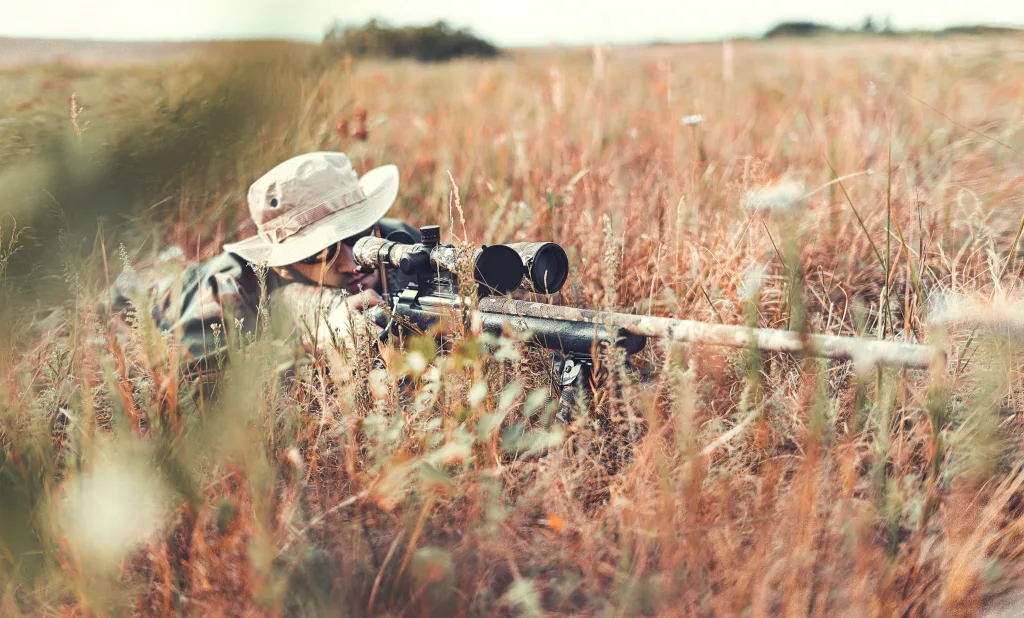Good marksmanship is an essential skill for anyone involved in shooting sports or hunting. It refers to the ability to consistently and accurately hit the target where intended. This skill is crucial for several reasons, with the most important being the need for accuracy in order to achieve a clean kill.
To become a proficient marksman, there are three fundamental aspects that need to be mastered: proper sight adjustment or patterning, proper shooting technique, and regular practice. These fundamentals form the foundation of good marksmanship and allow shooters to troubleshoot, correct, and improve their shooting technique.
One of the first elements of good marksmanship is proper sight adjustment or patterning. This involves ensuring that the sights on your firearm are properly aligned and adjusted to accurately represent the point of impact. Without proper sight alignment, even the most skilled shooter will struggle to hit the target consistently. Similarly, patterning refers to the process of determining the specific impact point of a particular load or bullet at various distances. This knowledge is crucial for making accurate shots in real-life shooting situations.
The second fundamental aspect of good marksmanship is proper shooting technique. This includes factors such as maintaining a steady position, achieving proper sight alignment and sight picture, controlling your breath, and executing a smooth trigger pull. A steady position is essential to provide a stable platform and a direct line of sight to the target. Sight alignment refers to aligning the front and rear sights correctly, while sight picture involves placing the aligned sights on the target. Breath control is crucial to minimize movement and ensure a steady aim. Lastly, trigger control refers to smoothly pressing the trigger without disturbing the sight alignment. Mastering these elements of shooting technique is essential for consistent accuracy.
The final component of good marksmanship is regular practice. Practice is the key to refining and maintaining shooting skills. It allows shooters to develop muscle memory, improve their technique, and become more comfortable and confident with their firearm. By practicing regularly, shooters can develop the necessary skills to accurately hit the target in different shooting scenarios, including hunting situations.
When it comes to hunting, good marksmanship is of utmost importance. A firearm used for hunting should be powerful enough to kill the game quickly and effectively. It is essential to choose a firearm that fits the shooter properly and has the correct amount of recoil. This is important because a properly fitting firearm and moderate recoil will encourage shooters to practice more often, leading to improved proficiency.
Good marksmanship is crucial for accuracy in shooting sports and hunting. It is built on the fundamentals of proper sight adjustment, shooting technique, and regular practice. Accuracy is essential for a clean kill, making marksmanship an important skill for ethical hunting. By mastering these fundamentals and practicing regularly, shooters can improve their marksmanship skills and increase their chances of hitting the target accurately.
Why Is Good Marksmanship Important?
Good marksmanship is of utmost importance for a variety of reasons. Here are some key points to understand its significance:
1. Accuracy: Good marksmanship ensures that a shooter can consistently hit the intended target with precision. This is crucial in various scenarios, such as self-defense, law enforcement, or military operations. Accuracy minimizes the risk of collateral damage and maximizes the chances of successfully neutralizing a threat.
2. Clean kill: In hunting or combat situations, a clean kill is essential to reduce suffering and ensure ethical and humane treatment of the target. Good marksmanship allows for precise shot placement, increasing the chances of an instant and humane kill.
3. Safety: A skilled marksman can maintain control over their shots, reducing the risk of stray bullets or unintentional hits on unintended targets. This is critical in crowded or dynamic environments where bystanders or friendly forces may be present.
4. Efficiency: By hitting the target accurately, good marksmanship minimizes the need for follow-up shots. This not only conserves ammunition but also decreases the time required to neutralize a threat, potentially saving lives and resources.
5. Confidence: Developing good marksmanship skills builds confidence in one’s abilities. This confidence can contribute to better decision-making and overall performance in high-pressure situations.
6. Competitive shooting: For individuals participating in shooting competitions, good marksmanship is essential to achieve high scores and success in the sport. Consistently hitting the target at various distances and under different conditions is key to winning competitions and improving overall shooting skills.
Good marksmanship is crucial for accuracy, clean kills, safety, efficiency, confidence, and success in shooting competitions. It plays a vital role in various fields, including self-defense, law enforcement, military operations, and hunting.

What Is Key To Being A Good Marksman?
To become a skilled marksman, there are three key fundamentals that need to be mastered: proper sight adjustment or patterning, proper shooting technique, and consistent practice. Let’s delve into each of these elements in detail:
1. Proper sight adjustment or patterning:
– Understanding how to adjust your sights or pattern your firearm is crucial. This involves aligning the front and rear sights correctly for accurate aim.
– Sight adjustment usually involves moving the front or rear sight in small increments to compensate for windage (horizontal adjustment) or elevation (vertical adjustment).
– Patterning refers to the process of determining the bullet’s impact on the target at different distances. This helps you understand how your firearm performs, allowing you to make necessary adjustments for accurate shooting.
2. Proper shooting technique:
– Developing and maintaining a consistent shooting technique is essential for accuracy.
– Grip: Ensure a firm and stable grip on the firearm, allowing for control and minimizing recoil.
– Stance: Adopt a comfortable and balanced stance, such as the isosceles or Weaver stance, which provides stability and control.
– Breath control: Learn to control your breathing to minimize movement while aiming and taking the shot. Timing your shot between breaths is often recommended.
– Trigger control: Mastering the skill of smoothly squeezing the trigger without jerking or anticipating the shot is vital for accuracy.
3. Practice:
– Regular and focused practice is the foundation of becoming a good marksman.
– Consistency: Practice regularly to reinforce proper techniques and build muscle memory.
– Varied scenarios: Train in different shooting positions, distances, and environmental conditions to mimic real-world situations.
– Dry firing: Practice without live ammunition to improve trigger control and sight alignment.
– Seeking feedback: If possible, work with an experienced instructor who can provide guidance, identify areas for improvement, and offer constructive criticism.
Remember, becoming a good marksman takes time and dedication. By mastering the fundamentals, consistently practicing, and seeking continuous improvement, you can enhance your marksmanship skills and achieve greater accuracy.
What Should Be True About Any Firearm You Choose To Use For Hunting?
When selecting a firearm for hunting, there are several factors that you should consider to ensure its suitability. Here are the key characteristics that should be true about any firearm you choose to use for hunting:
1. Adequate Power: The firearm should possess sufficient power to effectively and ethically kill the game you are hunting. Different types of game require different calibers and bullet weights. It is crucial to select a firearm that matches the size and toughness of the intended game. Using a firearm that lacks the necessary power can result in wounded and suffering animals.
2. Proper Fit: The firearm should fit you properly to ensure accurate and comfortable shooting. A well-fitted firearm allows for proper alignment of your eye with the sights, a natural and consistent grip, and optimal control. A firearm that doesn’t fit you well can lead to poor accuracy and potentially cause discomfort or even injury during extended use.
3. Appropriate Recoil: The amount of recoil, or the backward force generated when firing a firearm, should be manageable for you. It is generally recommended to choose a firearm with moderate recoil, as excessive recoil can lead to flinching, poor follow-through, and decreased accuracy. Additionally, a firearm with moderate recoil encourages more frequent practice, thereby enhancing your shooting proficiency.
To summarize, the firearm you choose for hunting should possess sufficient power to dispatch the game effectively, fit you properly for accurate shooting, and have a recoil level that is manageable and conducive to consistent practice. By considering these factors, you can select a firearm that meets your hunting needs and enhances your overall hunting experience.
What Are The Four Fundamentals Of Marksmanship?
The four fundamentals of marksmanship are essential elements that every shooter should be familiar with in order to improve their shooting technique. They include:
1. Steady Position: It is crucial to select a position and stance that provide a steady platform for shooting. This helps in maintaining stability and reducing any unnecessary movement that can affect accuracy. A direct line of sight to the target should also be ensured.
2. Sight Alignment and Sight Picture: Proper sight alignment refers to aligning the front and rear sights of a firearm with the target. This helps in aiming accurately. Sight picture, on the other hand, is the relationship between the aligned sights and the target. Achieving a clear and focused sight picture is essential for accurate shooting.
3. Breath Control: Controlling breathing is important to minimize the movement of the shooter’s body. Taking a deep breath and holding it momentarily before taking a shot helps in reducing any involuntary movements caused by breathing. This allows for greater stability and precision.
4. Trigger Control: Trigger control refers to the proper manipulation of the trigger to initiate the shot. It is important to apply smooth and steady pressure on the trigger without jerking or flinching. This ensures a surprise break and minimizes any disturbance to the sight alignment and sight picture.
By understanding and implementing these four fundamentals, shooters can troubleshoot, correct, and improve their shooting technique, leading to better accuracy and precision.

Conclusion
Good marksmanship is a crucial skill for any shooter, whether they are hunting or participating in target shooting. It is the ability to consistently and accurately hit the intended target. Achieving good marksmanship requires three fundamental elements: proper sight adjustment or patterning, proper shooting technique, and regular practice.
Proper sight adjustment or patterning is essential in ensuring that the firearm is properly aligned with the target. This involves adjusting the sights or scope to match the point of impact with the desired point of aim. By doing so, the shooter can ensure that their shots will consistently hit the target where intended.
Proper shooting technique is another vital aspect of good marksmanship. This includes selecting a steady position and stance that provide a stable platform for shooting. It also involves mastering sight alignment and sight picture, which means aligning the front and rear sights accurately and maintaining a clear and focused view of the target. Additionally, breath control plays a role in marksmanship, as it helps to steady the shooter’s aim, and trigger control is crucial in ensuring a smooth and controlled release of the shot.
Lastly, regular practice is key to developing and maintaining good marksmanship skills. By practicing regularly, shooters can refine their technique, build muscle memory, and improve their overall accuracy. It is also important to choose a firearm that fits the shooter properly and has a manageable level of recoil, as this will encourage more frequent practice and ultimately lead to greater proficiency.
Good marksmanship is achieved through proper sight adjustment, mastering shooting techniques, and regular practice. By focusing on these fundamental elements, shooters can improve their accuracy and ensure a clean and effective shot, whether it be for hunting or target shooting.
